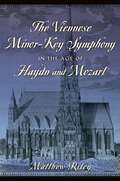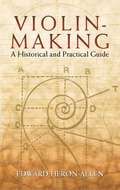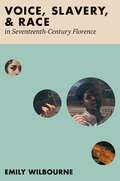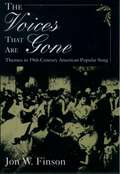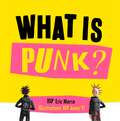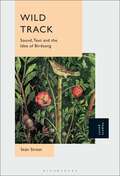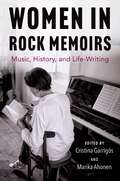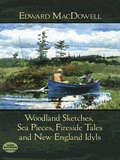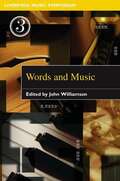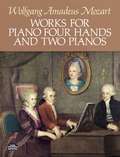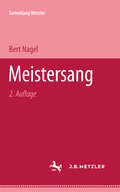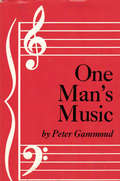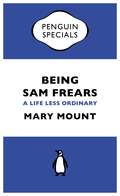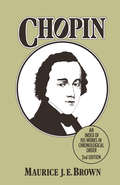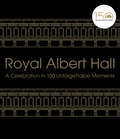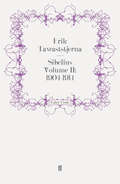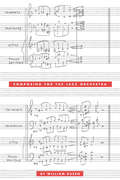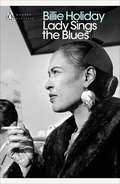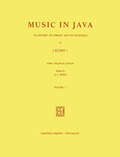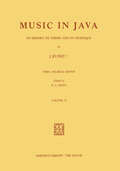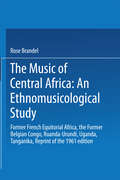- Table View
- List View
Violin-Making: A Historical and Practical Guide
by Edward Heron-AllenThis classic guide offers an accessible initiation into the mysteries of violin-making. Charming in its style and cultivated in its research, it covers every detail of the process, from wood selection to varnish. A fascinating history of the instrument precedes discussions of materials and construction techniques. More than 200 diagrams, engravings, and photographs complement the text.Author Edward Heron-Allen served an apprenticeship with Georges Chanot, a preeminent nineteenth-century violin maker. The knowledge, skill, and experience Heron-Allen acquired in the master's shop are reflected in this book, which was the first to combine the history, theory, and practice of violin-making. Originally published in 1884 as Violin-Making, As It Was and Is: Being a Historical, Theoretical and Practical Treatise on the Science and Art of Violin-Making for the Use of Violin Makers and Players, Amateur and Professional, this volume has enlightened and informed generations of performers and players alike.
Voice, Slavery, and Race in Seventeenth-Century Florence
by Emily WilbourneGrounded in new archival research documenting a significant presence of foreign and racially-marked individuals in Medici Florence, this book argues for the relevance of such individuals to the history of Western music and for the importance of sound-particularly musical and vocal sounds-to systems of racial and ethnic difference. Many of the individuals discussed in these pages were subject to enslavement or conditions of unfree labor; some labored at tasks that were explicitly musical or theatrical, while all intersected with sound and with practices of listening that afforded full personhood only to particular categories of people. Integrating historical detail alongside contemporary performances and musical conventions, this book makes the forceful claim that operatic musical techniques were-from their very inception-imbricated with racialized differences. Author Emily Wilbourne offers both a macro and micro approach to the content of this book. The first half of the volume draws upon a wide range of archival, theatrical and historical sources to articulate the theoretical interdependence of razza (lit. "race"), voice, and music in early modern Italy; the second half focuses on the life and work of a specific, racially-marked individual: the enslaved, Black, male soprano singer, Giovannino Buonaccorsi (fl.1651-1674). Voice, Slavery, and Race in Seventeenth-Century Florence reframes the place of racial difference in Western art music and provides a compelling pre-history to later racial formulations of the sonic.
The Voices That Are Gone: Themes In Nineteenth-century American Popular Song
by Jon W. FinsonIn this unique and readable study, Jon Finson views the mores and values of nineteenth-century Americans as they appear in their popular songs. The author sets forth lyricists' and composers' notions of courtship, technology, death, African Americans, Native Americans, and European ethnicity by grouping songs topically. He goes on to explore the interaction between musical style and lyrics within each topic. The lyrics and changing musical styles present a vivid portrait of nineteenth-century America. The composers discussed in the book range from Henry Russell ("Woodman, Spare That Tree"), Stephen Foster ("Oh! Susanna"), and Dan Emmett ("I Wish I Was in Dixie's Land"), to George M. Cohan and Maude Nugent ("Sweet Rosie O'Grady"), and Gussie Lord Davis ("In the Baggage Coach Ahead"). Readers will recognize songs like "Pop Goes the Weasel," "The Yellow Rose of Texas," "The Fountain in the Park," "After the Ball," "A Bicycle Built for Two," and many others which gain significance by being placed in the larger context of American history.
What is Punk?
by Eric MorseOnce upon a time, there was a deafening roar, that awakened the people, like never before ...What Is Punk? is a must-read pop-culture primer – an introduction to the punk revolution, recreated in vivid 3D clay photographs and told through rhyming couplets.From London’s Sex Pistols and The Clash to the Ramones’ NYC protopunk, from Iggy Pop to X-Ray Spex, this volume depicts some of our culture’s seminal moments and iconic characters.A delightful read for adults and children alike, illustrated in a truly unique visual style, What Is Punk? lays the groundwork for the next generation of little punks.
Wild Track: Sound, Text and the Idea of Birdsong
by Seán StreetWild Track is an exploration of birdsong and the ways in which that sound was conveyed, described and responded to through text, prior to the advent of recording and broadcast technologies in the late 19th and early 20th centuries. Street links sound aesthetics, radio, natural history, and literature to explore how the brain and imagination translate sonic codes as well as the nature of the silent sound we "hear" when we read a text. This creates an awareness of sound through the tuned attention of the senses, learning from sound texts of the natural world that sought – and seek – to convey the intensity of the sonic moment and fleeting experience. To absorb these lessons is to enable a more highly interactive relationship with sound and listening, and to interpret the subtleties of audio as a means of expression and translation of the living world.
Women in Rock Memoirs: Music, History, and Life-Writing
Women in Rock Memoirs vindicates the role of women in rock music. The chapters examine memoirs written by women in rock from 2010 onwards to explore how the artists narrate their life experiences and difficulties they had to overcome, not only as musicians but as women. The book includes memoirs written by both well-known and lesser-known artists and artists from both inside and outside of the Anglo-American sphere. The essays by scholars from different research areas and countries around the world are divided into three parts according to the overall themes: Memory, Trauma, and Writing; Authenticity, Sexuality, and Sexism; and Aging, Performance, and the Image. They explore the dynamics of memoir as a genre by discussing the similarities and differences between the women in rock and the choices they have made when writing their books. As a whole, they help form a better understanding of today's possibilities and future challenges for women in rock music.
Woodland Sketches, Sea Pieces, Fireside Tales and New England Idyls
by Edward MacDowellEdward MacDowell (1860-1908) was America's most prominent nineteenth-century composer. Championed by Franz Liszt, he was one of the first U.S. composers to gain international recognition. A leading exponent of the Romantic tradition, he was a prolific composer for the piano. This outstanding collection presents his best, most characteristic works, reprinted from original editions. They include:Woodland Sketches, Op. 51Sea Pieces, Op. 55Fireside Tales, Op. 61New England Idyls, Op. 62These beautiful and affecting compositions reflect not only MacDowell's poetic Romanticism but also his virtuosic skills as a pianist, which won him an international reputation as a concert artist. Intermediate- and advanced-level pianists will appreciate the lyric intensity and ebullient spirit of these pieces.
Words and Music (Liverpool Music Symposium #3)
by J. G. WilliamsonWord and music studies is a relatively young discipline that has nonetheless generated a substantial amount of work. Recent studies in the field have embraced music in literature (word music, formal parallels to music in literature, verbal music), music and literarature (vocal music) and literature in music (programme music). Other positions have been defined in which song exists as an analysable category distinct from words and music and requiring its own grammar. Much of the literature has tended to focus on readings of the literary text, pushing theoretical and analytical concerns in music to one side, a trend that is as apparent among musicologists as among literary historians. The essays presented here from the third Liverpool Music Symposium seek accordingly to redress this situation. Contributors tackle the study of words and music from a number of standpoints, examining artists as diverse as Eminem, Patti Smith and Arnold Schoenberg.
Works for Piano Four Hands and Two Pianos (Dover Music For Piano Ser.)
by Wolfgang Amadeus MozartFrom his earliest years. Mozart played piano duets with his sister, and as his musical career progressed he created a small repertoire of masterly four-hand piano compositions that are among the most admired and performed in this distinctive genre.This Dover edition presents six of these choice works, plus two compositions Mozart wrote for two pianos all reprinted from the authoritative Breitkopf & Härtel edition: Sonatas in D Major (K.381/123a), B-flat Major (K.358/186c), F Major (K.497), G Major (K.497a and 500a), and C Major (K.521) and Theme and Variations in G Major (K.501). Also for 2 pianos: Sonata in D Major (K.448/375a) and Fugue in C Minor (K.426). Duet enthusiasts will discover in these charming works the sparkling elegance, varied moods, and fluid textures that constitute the very essence of Mozart's musical personality.
One Man's Music
by Peter GammondOne Man's Music is a love story - the story of Peter Gammond's relationship with music from earliest childhood. The growth of the relationship is, has been - and still is - deltaic, branching out through every phase and aspect of Western European and North American music: classical, light, jazz and even pop. Despite its range and depth, the book is not the least degree a textbook or scholarly treatise. But is: HISTORICAL neither formally nor chronologically but ranging through the key developments in all periods of music; CRITICAL it makes no pretence to be comprehensive but deals with many individual composers and styles; WIDE-RANGING It examines all types of music from classics to pop: orchestral music, church music, opera, musical comedy, popular music and jazz; PERSONAL the approach is frankly individual, often autobiographical; ENTERTAINING. the subject matter is fascinating and the style - with more than a sprinkling of satirical humour - is extremely engaging; KNOWLEDGEABLE the personal approach is complemented by a wealth of reference material of a catholic and unpredictable nature. Aged 93, Peter lives in Shepperton with his wife Anna where they still enjoy listening to music.
The operas of Leos Janacek: The Commonwealth and International Library: Music Division
by Erik ChisholmThe Operas of Leoš Janáček presents the comprehensive analysis of Leoš Janáček's operas. This book presents a concise account of Janáček's extraordinary musical background and development as an operatic composer. Organized into seven chapters, this book begins with an overview of Janáček's visit to the London Zoo in 1926, which profoundly influenced his very personal compositional style when he recorded the different cries and sounds of animals in musical notation. This text then describes the nature of Janáček's last two operas, which are characterized by emotional stresses, psychological conflicts, and the turbulence of text and music. Other chapters describe pastoral symphony of the opera The Cunning Little Vixen, which is a touching and sincere tribute to the basic unity of all living creatures of nature. This book discusses as well the characteristic explosive musical prose writing of Janáček. This book is a valuable resource for musicians, instrumentalists, and composers.
Being Sam Frears: A Life Less Ordinary (Penguin Specials)
by Mary MountThis is Sam Frears' story.This is also the story of an actor, a rock-climber and a man born with an extremely rare genetic disorder only affecting Ashkenazi Jews. Sam was supposed to live to the age of 5. In February, he celebrated his 40th birthday.Challenged by blindness and a body under great stress, Sam Frears is trying to live an ordinary life under extraordinary circumstances His struggles and triumphs offer an illuminating look at the differences - and similarities - that make us human. For those who enjoyed My Left Foot and Stuart: A Life Backwards, this Penguin Special offers a fresh look at what it's like to be Sam.
Royal Albert Hall: A celebration in 150 unforgettable moments
by Royal Albert HallThe most iconic concert hall in the world celebrates 150 years with a stunning review of history's finest performances and performers. Opening with a personal letter from Queen Elizabeth II, this beautiful book celebrates 150 moments that have shaped The Royal Albert Hall over the last century and a half. From The Beatles to the Suffragettes, Albert Einstein to Winston Churchill, Mohammed Ali to B.B. King, few other buildings have housed such a stunning variety of era-defining people and events.This gorgeous, illustrated guide takes you behind the scenes of one of the most well-loved concert halls in the world, offering insights into the building’s iconic architecture, as well as its lesser-known quirks such as the reinforced toilets designed for Sumo wrestlers. This book features events ranging from the world's first sci-fi convention in 1891 to the annual Cirque du Soleil, which requires the auditorium to be transformed into a gymnasium. Autographs and candid comments from incredible performers who have appeared on its stage, like Russell Howard, Eric Clapton and Katie Derham, give a unique insider’s perspective on an esteemed and beloved British institution. With never-before-seen images, insights and more, this is the ultimate celebration of a British architectural icon which continues to inspire artists and audiences from around the world.
Sibelius Volume II: 1904-1914
by Erik TawaststjernaErik Tawaststjerna embarked on his monumental and acclaimed study of Jean Sibelius's life and music in 1960 and it occupied him for over a quarter of a century. His study differs from other work on the composer in one important respect: he had unrestricted access to the composer's papers, diaries and letters as well as the advantage of numerous conversations with the composer's widow and other members of the family. Thus his researches can justifiably claim to have thrown entirely fresh light on the great Finnish composer. Far from the remote personality of the Sibelius legend, Sibelius emerges as a highly colourful figure. This second volume covers the crucial period from 1904 and the beginning of the Third Symphony through to the outbreak of the First World War ten years later. During this period Sibelius began keeping a diary which, together with his letters to his wife, Aino, and to his friend, Axel Carpelan, helped the author give us a day-by-day, intimate account of the turbulent years that saw the gestation and completion of many of his finest works, culminating in the Fourth Symphony. Translated by Robert Layton, himself a Sibelius specialist, this is a compelling and insightful account of the music of one of the twentieth century's greatest composers.
Composing for the Jazz Orchestra
by William Russo"Although it will be of primary interest to those who are engaged in composition themselves, [this] book is also recommended for readers who may wish to gain further insight into just what makes jazz composition so different from traditional approaches."—Malcolm Bessom, The Music Magazine
Composing for the Jazz Orchestra
by William Russo"Although it will be of primary interest to those who are engaged in composition themselves, [this] book is also recommended for readers who may wish to gain further insight into just what makes jazz composition so different from traditional approaches."—Malcolm Bessom, The Music Magazine
Composing for the Jazz Orchestra
by William Russo"Although it will be of primary interest to those who are engaged in composition themselves, [this] book is also recommended for readers who may wish to gain further insight into just what makes jazz composition so different from traditional approaches."—Malcolm Bessom, The Music Magazine
Composing for the Jazz Orchestra
by William Russo"Although it will be of primary interest to those who are engaged in composition themselves, [this] book is also recommended for readers who may wish to gain further insight into just what makes jazz composition so different from traditional approaches."—Malcolm Bessom, The Music Magazine
Lady Sings the Blues: Lady Sings The Blues (Penguin Modern Classics)
by Billie Holiday"I've been told that no one sings the word 'hunger' like I do. Or the word 'love'."Lady Sings the Blues is the inimitable autobiography of one of the greatest icons of the twentieth century. Born to a single mother in 1915 Baltimore, Billie Holiday had her first run-in with the law at aged 13. But Billie Holiday is no victim. Her memoir tells the story of her life spent in jazz, smoky Harlem clubs and packed-out concert halls, her love affairs, her wildly creative friends, her struggles with addiction and her adventures in love. Billie Holiday is a wise and aphoristic guide to the story of her unforgettable life.
Music in Java: Its History, Its Theory and Its Technique
by J. KunstOne day in the summer of 1921 a postal delivery brought me a little packet of reprints from the periodical "Djawa" : articles about Indonesian music by Dr. JAAP KUNST, which until that moment had not come to my notice. A cursory glance was enough to convince me that the author was a very gifted man, who had made a sound and absolutely scientific study of the subject, and thereby made a valuable contribution, by means of careful observation and actual tone-measurements, to the facts known from the older studies by GRONEMAN, LAND and ELLIS. These measure ments were particularly satisfying to me personally, since they constituted an astonishing confirmation of a hypothesis concerning the genesis of tone systems (through the "cycle of blown fifths"), which I had propounded two years previously, without, however, having published it. At the same time it was proved, through the perfect conformity existing between the measured and the theoretical absolute pitches (vibration frequencies), that Indonesian gamelan tuning, too, belongs to the radius of ancient Chinese culture - much the same as is the case with Pan-pipes and xylo phones all over· the world. The first contact between Dr. KUNST and myself led to a regular cor respondence, which especially contributed to a further development of the above-mentioned theory of tone-systems.
The Music of Central Africa: Former French Equatorial Africa the Former Belgian Congo, Ruanda-Urundi Uganda, Tanganyika
by R. BrandelUnder the inspiring guidance of my mentor, Curt Sachs, this work was conceived, planned, and executed. It gained in dimension under the acute and patient perusal of Gustave Reese to whose brilliant propensity for clarity of thought and of style lowe a huge debt. Furthermore, the helpful suggestions made by Martin Bernstein and by Jan LaRue are gratefully acknowledged. If Jaap Kunst had not kindly gone to the trouble of ordering, supervising the con struction of, and mailing to me from Amsterdam his personally designed monochord, an important section of this work could not have taken form. This preface is not complete, of course, without final thanks to my husband, Harvey B. N atanson, for his sustained interest and encouragement. R. B. Note As the present work goes to press, the political map of Africa is flowing into a new mold. Several countries have obtained independence, and new names and data should be con sidered: French Equatorial Africa has become (November 28-December I, 1958) four independent countries - Republic of the Congo: Brazzaville (formerly Middle Congo), Gabon Republic (formerly Gabon), Central African Republic (formerly Ubangi-Shari), and Republic of Chad (formerly Chad). The Belgian Congo has become (June 30, 1960) the Republic of the Congo: Leopoldville.
